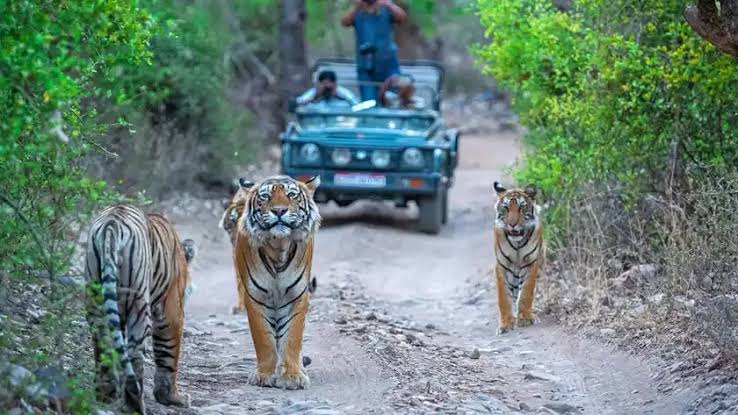Precautionary Principle

- 15 Apr 2024
Why is it in the News?
The precautionary principle is becoming an established guideline for policymakers tackling environmental problems according to British environmentalist Norman Myers
What is the Precautionary Principle?
- The Precautionary Principle serves as a foundational concept in policymaking, advocating for the adoption of proactive measures to mitigate potential risks to public health or the environment:
- Proactive Risk Management: The principle legitimizes the implementation of preventative measures in situations where there are uncertainties regarding the extent of harm posed by certain activities or policies.
- Rather than waiting for conclusive scientific evidence, decision-makers are encouraged to take preemptive action to prevent serious or irreversible damage.
- Scientific Uncertainty: It acknowledges that in cases where scientific certainty is lacking, waiting for conclusive evidence before taking action may result in significant harm.
- Therefore, the principle emphasizes the importance of not using the absence of full scientific certainty as a justification for delaying necessary measures to prevent environmental degradation or protect public health.
- Risk-Averse Approach: By advocating for precautionary action, even in the absence of absolute certainty about potential harm, the principle prioritizes safety and prudence.
- It underscores the importance of erring on the side of caution to safeguard against potential risks, thus emphasizing a preventive rather than reactive approach.
- International Recognition: Originating in the 1970s, the Precautionary Principle has gained international recognition and has been enshrined in various international treaties and conventions related to environmental protection.
- It has been incorporated into the legal frameworks of organizations such as the European Union and has influenced decisions on issues ranging from climate change to biodiversity conservation.
- Application in Policy: The principle has influenced the development of laws and regulations worldwide, shaping policies related to endangered species, climate change, and genetically modified organisms (GMOs).
- Notably, it has played a significant role in determining the European Union's stance on GMOs and has been integral to the formulation of EU environmental law.
- The Precautionary Principle emphasizes the importance of taking proactive measures to address potential risks, particularly in situations where scientific evidence is uncertain but the potential consequences are significant.
- It embodies a proactive and risk-aware approach to policymaking, intending to prevent harm and promote sustainable development.
About Jim Corbett National Park:
- Jim Corbett National Park, named after the renowned naturalist and conservationist Jim Corbett, is situated in Uttarakhand's Nainital district.
- As the oldest national park in India, it was initially established as Hailey National Park in 1936 to protect the endangered Bengal tiger.
- The park is an integral part of the larger Corbett Tiger Reserve, with the Patli Dun Valley forming its core area.
- The Ramganga River flows through the park, contributing to its diverse ecosystem.
- Not only is it known for its rich biodiversity, but also for being the first area to come under the Project Tiger initiative in 1973.
Trees in Corbett fell prey to greedy nexus, says Supreme Court

- 07 Mar 2024
Why is it in the News?
The Supreme Court on Wednesday condemned the illegal felling of over 6,000 trees to construct buildings, ostensibly for “eco-tourism” at the Jim Corbett National Park in Uttarakhand, as a “classic case” of nexus between politicians and officials working to ransack the environment for short-term commercial ends.
News Summary:
- In 2023, a series of applications brought attention to the creation of alleged illegal buildings and encroachment on water bodies, prompting court intervention.
- Petitioners highlighted violations of environmental norms and encroachment into core wildlife habitats.
- Evidence presented during proceedings revealed unauthorized constructions within the national park, including concrete and iron enclosures purportedly intended for a 'safari' experience.
- Moreover, it was disclosed that over 6,000 trees had been felled in the national park under the pretext of safari development.
Supreme Court’s Observations:
- The Court has raised concerns regarding the necessity of developing facilities within natural forest environments, particularly in areas designated for the protection of endangered species like tigers.
- Directing the Government to establish a committee, the Supreme Court seeks recommendations on whether tiger safaris should be permitted in buffer or fringe areas and what guidelines should govern their establishment if allowed.
- Additionally, the Court has strongly criticized the illegal constructions and extensive tree felling in Uttarakhand's Corbett National Park.
What are the Core and Buffer Areas in Tiger Reserves?
- As per the Wild Life (Protection) Amendment Act of 2006, a Tiger Reserve comprises core or critical habitat and a buffer zone surrounding it.
- Core areas hold the legal status of a National Park or a Sanctuary.
- Buffer zones consist of a mix of forest and non-forest land, managed as a multiple-use area.
- The buffer area acts as a protective barrier, absorbing the impact of poaching pressure on tiger and other wildlife populations.
About Jim Corbett National Park:
- Location: Situated in the Nainital district of Uttarakhand, Jim Corbett National Park is renowned for its rich biodiversity.
Key Facts:
- Established in 1935, it is India’s oldest national park.
- Initially named Hailey National Park after its founder Sir Malcolm Hailey, it was renamed Corbett National Park in 1956 to honor Jim Corbett's contributions to wildlife preservation in India.
- Corbett National Park boasts the highest population of tigers in India, highlighting its importance for tiger conservation efforts.
- Flora: Dominated by Sal, Semal, Kharpat, Sissoo, Khair, Dhak, Khingan, Bakli, Bel, Ber, Bamboo, Khingam, Jamun, Kanju, Rohini, and Pula trees.
- Sal, Khair, and Sissoo are prominently featured throughout the park.
- Fauna: Home to diverse wildlife including Tiger, Leopard, Elephant, Chital Deer, Sambar Deer, Hogg Deer, Barking Deer, Wild Boar, Langur, Wild pig, Rhesus Monkey, Jackal, Rabbit, Yellow Throated Martin, and Otters.
- Various reptiles such as Crocodile, Gharial, King Cobra, Common Krait, Cobra, Russell's Viper, Rock Python, and Monitor Lizard inhabit the park.
- The Kosi River feeds the eastern periphery of Corbett National Park.
- The Ramganga River (West) and its tributaries Sonanadi, Palain, and Mandal serve as significant hydrological resources for the park.
